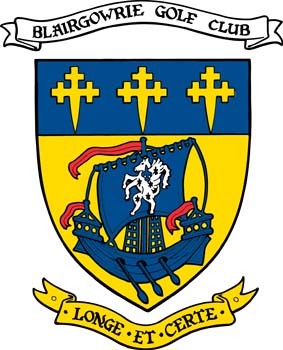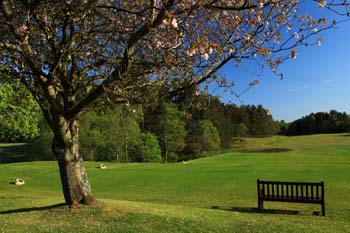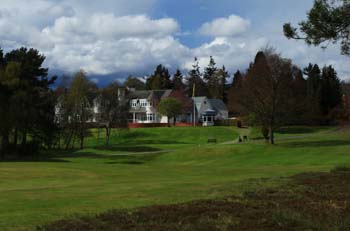Meet the manager: Blairgowrie GC’s 31-year-old leader, Steven Morgan
The Scottish golf club’s managing secretary talks about how he became manager of a prestigious and traditional private members’ club, the work being done to recruit more junior golfers and the five-year plan the club has

How does a 31-year-old become the managing secretary of Blairgowrie Golf Club?
I started my career in golf at the Gleneagles Hotel, working in the golf shop. Having always been a keen golfer, I decided to turn professional and work through the PGA programme and thus become an assistant at the world-famous Turnberry Hotel.
After five years at Turnberry I was headhunted by Leisurecorp to help them establish and develop the Golf Academy at Pearl Valley in South Africa and my impact there presented an opportunity at Yas Links in Abu Dhabi, where I joined as head professional and later was promoted to director of golf.

After four hugely enjoyable and informative years in the Middle East I was head hunted by IMG to lead the team at the renowned Nirwana Bali Golf Club, and later seconded to their head office in London to assist in running their luxury portfolio of European golf clubs and resorts.
You only took up the post earlier this year. What are the immediate challenges you’ve identified and how will you be addressing these?
Blairgowrie Golf Club has long been considered one of Scotland’s top inland venues due mainly to its conditioning, presentation and playability of its golf courses. One of the immediate challenges would be to maintain this reputation and provide continuity during the transition of my leadership whilst at the same time building on our guest service to ensure we deliver an exceptional golf experience.

How big is your team at Blairgowrie, what is the current departmental / management structure and how well does this currently serve the needs of the club?
We have over 30 club employees who reported directly to me. Considering we have 45 holes of golf, a large clubhouse and a very busy events diary, the size of team is spot on and each department works well together.

You have experienced working internationally at a semi-private members’ club and a resort; two entirely different models of business. Are there any aspects of either of these models that you feel could be used to benefit the Blairgowrie business moving forward?
One of the most important aspects which I have learnt is communication, both with staff and members. This was very important when I was working overseas as you had the language barrier. Back home this is obviously not the case however it is so important to keep people informed of where you are going and how you are going to get there.

You have a five-year plan with a view to secure membership acquisition and retention, and drive visitor play revenue. What will you be doing to ensure you achieve these objectives?
Being a members’ club, it is important that we first focus on the membership and ensuring that we have strong retention trends as we reach the end of the year.
Membership retention, for me, lies in the ability to create an emotional connection with the member and to do this it comes back to genuine service delivery and strong communication. Of course, member value adds, such as reciprocal agreements and other partnerships are also important, and so we will look to add more of these throughout the rest of the season.

In terms of member acquisition, we will look to start with an attractive members’ referral programme which will allow our members to invite friends, family and co-workers to join ‘their’ club. This will essentially mean we have a sales team of 1,600 members working for their club to drive more members.
Visitor play is important to clubs and as such we will drive more business through dynamic pricing as we have the flexibility and available inventory with 45 holes of golf on offer. We also have a unique opportunity when the Open Championship is held at Carnoustie in 2018 and as such this will provide a wonderful platform to showcase our facility and hopefully capture some visitor business over an exciting week or two.

What plans have you set in place to achieve the goals of member incentives, improving events and engaging more with the members?
It’s about being active ‘out in the field’, being out and talking with members, getting to know them asking them questions about what we do well and what we can improve on. What it is that they value most about being a member of the club and what is it they want to see more of? Armed with this knowledge we can then make informed decisions, create plans and follow these up to ensure we fulfil the needs and wants of our large membership.

Identifying different markets is important for business survival. You used channel marketing when working abroad. Please can you explain how you identified opportunities and marketed to them to stimulate additional business.
Channel marketing, quite simply, is about knowing your main channels of business and how you are reaching out to these. It starts first with identifying who you sell to and how well you do this (a good point of sale system will provide this data in terms of sales). From here you can prioritise your marketing efforts based on data-driven statistics aimed at the right market segment, thus eliminating the possibility of diluting your mainstream segments.
For me, channel marketing allows a more targeted approach and provides the ability to more effectively measure success.

Training and development is something that you have benefitted from. Moving forward, what plans do you have for staff training and what benefits do you expect to deliver to the individual and club?
A number of our staff have been at the club a long time and this is great from a member and guest recognition perspective. So my first step with the team is really to provide direction for them so they are in tune with where we are and where we are going as a club. From here it is then about providing an environment for them to be motivated and empowered to delivering the very best of everything we do.

What is the current membership of the club in terms of number, age and gender profile. Who do you look to target for future membership, what overall level of membership are you looking to achieve and over what timeframe?
We have close to 1,600 members which is predominantly made up of men, our average age of membership is 57.
Our future lies in attracting the younger generation to the club as they are essentially the members of tomorrow. We have a number of great incentives in place to do this and so it is now up to myself and the team to make them feel part of something very special. Attracting families is very important to us and so we will look to add a number of family-friendly incentives to lure them into the club and the game of golf.

What are you doing to reach out to junior golfers and how will you engage with them to maintain interest and future growth for both them and the club?
We have an ambitious 12-month programme designed to lure the next generation into golf, which enjoys the Scottish Golf stamp of approval.
We have started first with weekly classes aimed at the eight-to-14 age group which ran until the end of July along with an open-to-all ‘Come and Try’ family event. We had some great support and turnout in these incentives and as such they become a great platform for us to build on.
We have now unveiled an ‘autumn in schools’ schedule which will see our assistant professionals taking golf into five local primary schools over the winter. We have some great Tri-Golf equipment left over from the Junior Ryder Cup event which we held in 2014 and so we will use this in the schools to make it both fun and easy to hit the balls.

On conclusion of the in schools’ programme we run a fun inter-schools team event which will encourage the youngsters to compete on our ‘Wee Course’, essentially this becomes the next step towards playing the real thing and joining a club.
The Rosemount course has undergone some reconstruction with the help of Graham Webster. What were the reasons for this, what changes were made and where, how has this improved the course and are the members happy?
Both the sixth and seventh holes on the Rosemount course have been fantastically reshaped and brought into the modern-day era. While the work has been extensive, it has also been sympathetic to the original Braid design.
The par three sixth green has a new expansive tee along with a new approach apron and subtle run-offs around the green. The new bunker at the front right of the green will soak up any weak shots from the tee and the new green will provide some wonderful new pin positions.

The seventh hole has been reshaped so that it becomes more of a dog-leg from the tee. Some clever new bunkering has also been added along with another expansive green which again is well protected by bunkers and run-offs.
All in all, the changes that have been made have been very well received and as such have made two ordinary holes into two very memorable holes.

No managing secretary can do the job without a team; which is having the right people in the right place doing the right thing at the right time. What is your management style and views on best working practices for the betterment of the club?
I would like to consider myself a leader. Someone who stands with the team and provides support, guidance and importantly direction. I constantly work towards being someone who motivates, empowers and inspires their team to deliver the very best experience at every available opportunity.

The pressures on the club manager to deliver a better product in terms of course, clubhouse, the facilities, food, bar, pro shop, quality, service and so on are mounting year-on-year, with the level of management professionalism having to rise in line with this. What do you think are the qualities now needed to meet the requirements and demands of members / players by someone in your position and how do you think this will help contribute to the long-term business of golf club management?
Creativity. We have a challenge in our industry to attract more people to the club and the game in general and as such we need to be creative in how we go about this. Thinking ‘outside of the box’ to offer a unique experience helps leave a lasting impression and hopefully ensures a return visit(s).

What currently gives you the greatest satisfaction from your current position and career to date, and why?
My current role is so diverse and sees me attending to a huge number of tasks on a daily basis. I get the most satisfaction when I have the time to get out from behind my desk to meet and greet our members and guests. Whether it be catching up with a member before or after their game or taking the time to welcome our guests, it makes the club experience more personalised and hopefully provides a lasting impression.

With your wealth of experience, what advice would you give to youngsters starting out and wanting to pursue a career in the golf club management profession?
Be open minded! I feel it’s important not to pigeon hole yourself into one aspect of the business. The golf industry has so much to offer and so it is important to learn and experience as many different channels before settling into one.
What changes do you think need to be made to benefit the industry sector and profession of the golf club manager?
Our industry needs more innovation, more creativity and more freedom to create new ways to drive improved guest experiences for members and guests alike. For too long there have been too many rules, too many regulations that need to be followed and adhered to. Whilst we should never forget where the game of golf started we need to focus on where we see our clubs in 10 to 15 years down the line. Making changes takes time and so it is important that we look longer down the road and put in required stepping stones to get there each and every year.















Whilst it’s commendable that Blairgowrie are trying to reduce the average age of their membership with their under 30 intermediate membership catagory, it’s disappointing that this has been done in a manner which discriminates against potential new members over the age of 30.
Fantastic article and very nice to see a younger GM like Steven doing extremely well. I hope to one day in be in a similar position to him as i gain experience within the golf industry. After 9 years in the Army i am hoping i can use some of my managerial skills i learnt on operations to help me achieve my goal of being a GM.
I had the pleasure of meeting Steven Morgan last week – lovely chap who deserves his post. Nice to have a forward thinking Golf Manager who understands the industry and can pull on his past experience for the benefit of Blairgowrie GC and Perth and Kinross area.